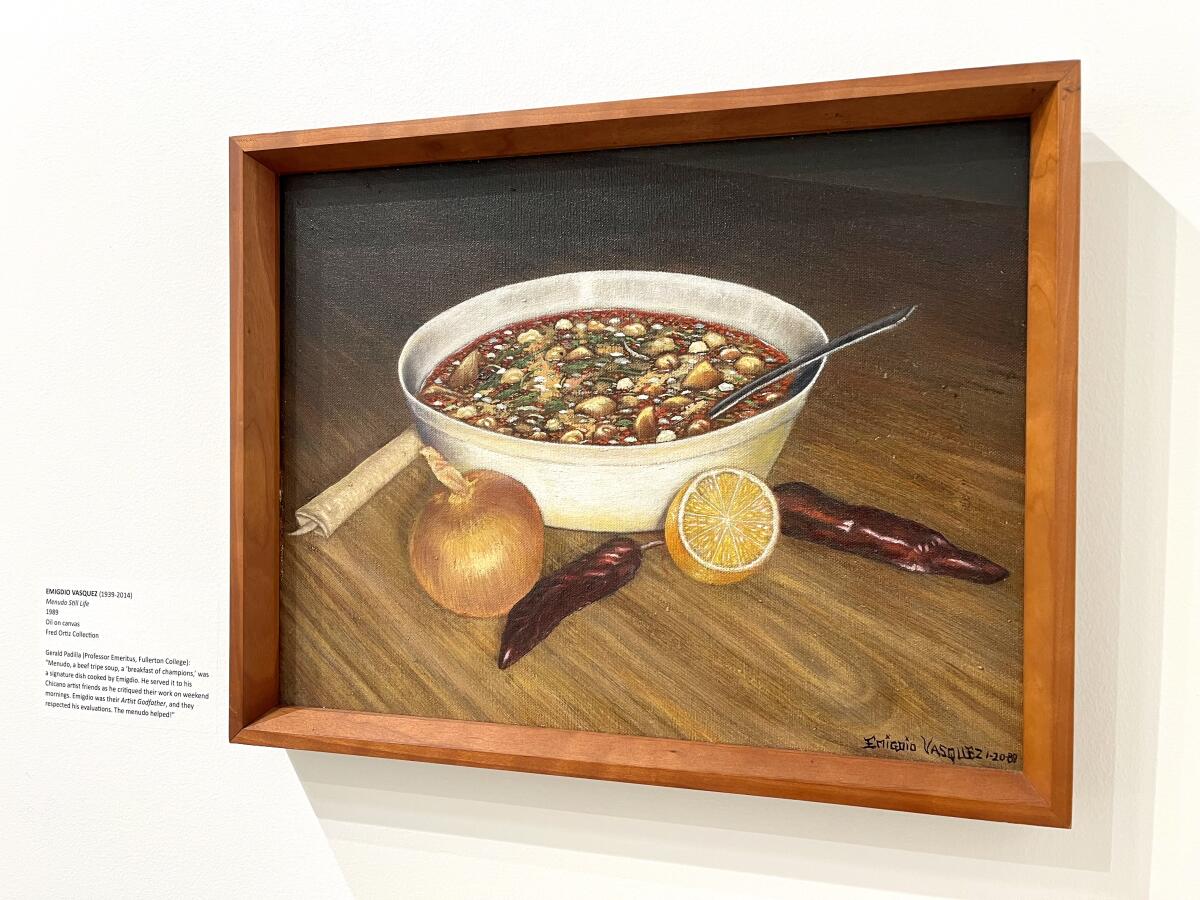Comfort in a bowl: Menudo, pozole and tortilla soup

‘Menudo Takes Guts’
There is quite a bit of familiar imagery in the works at Chapman University’s Hilbert Museum of California Art, which boasts one of the largest collections of California narrative art and reopened in Orange on Feb. 22, after a three-year remodel.
The Hilbert has tripled in size with nine new exhibitions across 26 galleries that include pieces by some of Southern California’s most well-known artists illustrating life in the Golden State.
Many of the works from the collection of Mark and Janet Hilbert feature familiar sites I recognize having grown up in California — Orange County specifically. A piece from David Hockney, depicting a swimming pool isn’t unlike the L-shaped pool that takes up most of my parents’ backyard. There is Phil Dike’s oil painting of the Plaza de Los Angeles from 1939, with the artist’s impression of the lively area adjacent to Olvera Street that still bustles with life today. Paintings of Valencia orange groves, glowing with sunny warmth and images of waves crashing against Laguna Beach’s rocky shores are all scenes I know well.
You are reading our Cooking newsletter
Sign up to get a taste of Los Angeles — and the world — in your own home and in your inbox every Friday
You may occasionally receive promotional content from the Los Angeles Times.
But when I turn the corner in an exhibit featuring California Chicano artist Emigdio Vasquez, my eyes settle on a singular work that reminds me the most of home: “Menudo Still Life.”
Vasquez was a highly regarded muralist and teacher, better known for his photo-realistic paintings of Chicano and Latin American history, rather than food. The exhibit, curated by Fred Apodaca Ortiz, features wonderful paintings of pachucos and pool halls, but the bowl of menudo on a wooden surface is different.
It is painted with the same regality one might expect of a Baroque-period still life of a bowl of fruit. The dish is surrounded by a whole onion, dried chiles and a halved lemon. There is a corn tortilla behind the bowl, rolled up tightly like a newspaper. I can practically smell this painting.
Menudo is the ultimate peasant dish, made with the once undesired offal meat of a butchered animal. Tripe, or cow stomach, and hominy simmer in a pot with red chile peppers and spices for hours before getting garnished with lemon, diced white onion, dried oregano and chile. Any Southern Californian knows it can be found at countless Mexican restaurants on Sundays and in Mexican American homes at the holidays.
Growing up, I knew if I awoke on a weekend to the smell of menudo downstairs, company was coming.
The soup has long been touted as a hangover cure and is much a part of Southern California’s landscape as coastal beaches and the San Bernardino Mountains. It was also Vasquez’s signature dish. According to former Fullerton College professor Gerald Padilla, Vasquez served menudo to his Chicano artist friends who sought his critique of their art on weekends.
“Emigdio was their Artist Godfather, and they respected his evaluations,” Padilla’s words read near the painting, “The menudo helped!”
Menudo always helps. You can make it at home, but as a T-shirt sold at a local menudo cooking competition in 1982 read, “Menudo Takes Guts.”
If you don’t have the guts (or at least a really good butcher), try our other recipes for Mexican soups that are just as hearty.
Eating out this week? Sign up for Tasting Notes to get our restaurant experts’ insights and off-the-cuff takes on where they’re dining right now.
Bill Torrez’s Red Menudo
Bill Torrez’s Red Menudo recipe is taken from a 1982 Times article about a Mexican American menudo cookoff in Indio. Torrez, a San Diego resident, competed in the championship division and his recipe calls for 10 pounds of tripe and four pigs feet. According to the article, the cooking competition sold T-shirts that said “Menudo Takes Guts.”
Get the recipe.
Cook time: 6 1/2 hours. Serves 20.
Pozole Estilo Jalisco (Jalisco-Style Pozole)

Pozole is an equally popular and hearty Mexican soup that is made with hominy and pork, rather than tripe. This Jalisco-Style Pozole recipe, adapted from a class taken in Guanajuato by the late L.A. Times Food writer Barbara Hansen, encourages you to use nixtamal instead of canned hominy for a truly authentic flavor.
Get the recipe.
Cook time: 3 hours 20 minutes. Serves 8 to 10.
Pozole Verde (Green Pozole)

Another pozole recipe adapted by Barbara Hansen, this one green, from the cooking class she took in Guanajuato. As she wrote in 2004, “We blended poblano chiles with cilantro and added that to the corn along with cooked chicken. The flavor is captivating, as appealing as green enchiladas. In the state of Guerrero, green pozole is thicker and contains tomatillos, explained our instructor, Luis Marhuani Marin Reyes.”
Get the recipe.
Cook time: 3 hours 10 minutes. Serves 8 to 10.
Enjoying this newsletter?
Consider becoming a Times subscriber.
Tomatillo Tortilla Soup

For a dish that is lighter than Mexican soups like menudo or pozole, but with the same healing proprieties try Sally Schmitt’s famous tomatillo tortilla soup. The French Laundry’s co-founder uses tart tomatillos to bring brightness in this savory tortilla broth.
Get the recipe.
Cook time: 45 minutes. Serves 4.
Have a cooking question?
Eat your way across L.A.
Get our weekly Tasting Notes newsletter for reviews, news and more.
You may occasionally receive promotional content from the Los Angeles Times.




